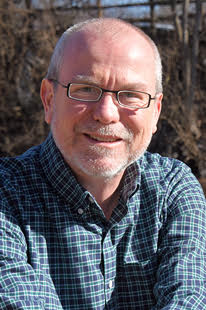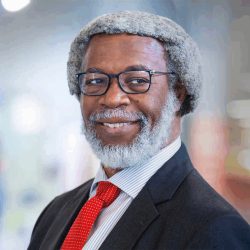UMD Professors Daniel Lathrop and Derek Richardson Named 2019 Distinguished Scholar-Teachers
They will be recognized during the university’s annual Convocation ceremony in the fall
University of Maryland Physics Professor Daniel Lathrop and Astronomy Professor Derek Richardson have been named 2019 Distinguished Scholar-Teachers. They will be recognized during the university’s annual Convocation ceremony on September 18, 2019.
The Distinguished Scholar-Teacher Program, established in 1978, honors a small number of faculty members each year who have demonstrated notable success in both scholarship and teaching. Distinguished Scholar-Teachers will make a public presentation on a topic within their scholarly discipline and will receive an honorarium of $5,000 to support their professional activities.
 An interdisciplinary researcher with additional joint appointments in UMD’s Department of Geology, Institute for Research in Electronics and Applied Physics, and Institute for Physical Science and Technology, Lathrop studies turbulence—the chaotic motion of fluids such as air or water. Understanding turbulence is crucial to studying phenomena such as the flow of air over an airplane wing, water flowing down a drain or the behavior of Earth’s molten outer core.
An interdisciplinary researcher with additional joint appointments in UMD’s Department of Geology, Institute for Research in Electronics and Applied Physics, and Institute for Physical Science and Technology, Lathrop studies turbulence—the chaotic motion of fluids such as air or water. Understanding turbulence is crucial to studying phenomena such as the flow of air over an airplane wing, water flowing down a drain or the behavior of Earth’s molten outer core.
Lathrop is particularly interested in Earth’s core, which generates a magnetic field that shields Earth from the sun’s radiation, allowing life to exist. Geological records show that the Earth’s magnetic field has reversed polarity numerous times in the past. When it does so, the magnetic field temporarily weakens, leaving the planet unprotected. However, scientists do not understand how Earth’s magnetic field is generated and what causes it to reverse. To investigate this question, Lathrop constructed a 3-meter spinning sphere filled with molten liquid sodium to model Earth’s core.
Lathrop is a fellow of the American Association for the Advancement of Science and the American Physical Society. He also received a Presidential Early Career Award from the National Science Foundation.
In addition to his research career, Lathrop is an enthusiastic mentor. Since joining UMD in 1997, he has mentored nine postdoctoral scholars, 19 Ph.D. students, 10 master’s degree students, and more than 60 undergraduate and high school students.
“It is rare—and wonderful—to find a teacher and mentor as fully engaged and enthusiastic as is Professor Lathrop,” wrote UMD Physics Chair Steven Rolston in a letter nominating Lathrop for the award. “He provides not only scientific knowledge but his deep-down love of the lab and of learning.”
Lathrop earned his B.A. in physics from the University of California, Berkeley, in 1987 and his Ph.D. in physics from the University of Texas at Austin in 1991.
 Richardson uses computational astrophysics to investigate and model the structure, dynamics, and evolution of small solar-system bodies, especially asteroids—small, rocky objects that orbit the sun. His work helps scientists devise methods to deflect asteroids from collision paths with Earth or land small spacecraft on the surfaces of asteroids and comets.
Richardson uses computational astrophysics to investigate and model the structure, dynamics, and evolution of small solar-system bodies, especially asteroids—small, rocky objects that orbit the sun. His work helps scientists devise methods to deflect asteroids from collision paths with Earth or land small spacecraft on the surfaces of asteroids and comets.
One of Richardson’s key insights is that many asteroids and comets are “flying rubble piles” comprising smaller pieces held together by their own gravity. For instance, data from the Rosetta mission, which landed a spacecraft on the surface of comet 67P/Churyumov–Gerasimenko, found that the comet was an aggregate structure of rocks, dust and ice. This understanding is essential for devising methods to deflect asteroids on collision paths with Earth, because pushing on a single rocky body to change its orbit is easier than influencing a loosely bound “rubble pile” of gravel and boulders.
Because of his expertise, Richardson is in high demand for projects that investigate the structure of asteroids. He is a co-investigator of the NASA Double Asteroid Redirection Test (DART) mission led by the Johns Hopkins University Applied Physics Laboratory. DART will crash a spacecraft into the small moon of an asteroid to see how the moon’s orbit around its parent body changes. Richardson’s theoretical interpretation of the eventual result, using his algorithms to understand energy and momentum transfer from the spacecraft to the moon, will be a key element of the mission’s scientific outcome.
Richardson received a Dean’s Award for Excellence in Teaching from UMD’s College of Computer, Mathematical, and Natural Sciences in 2016. In 2002, an asteroid was renamed “12566 Derichardson” in his honor.
In addition to his research, Richardson has mentored six Ph.D. students, four master’s degree students and 27 undergraduates since joining UMD in 2000.
“As a teacher, Professor Richardson stands out as a true innovator,” wrote UMD Astronomy Chair Andrew Harris in a letter nominating Richardson for the award. “His strong intellectual curiosity extends to teaching and mentoring at all levels, where he combines a unique flair for research and remarkable abilities to communicate the excitement of scientific research to students.”
Richardson earned his B.S. in astronomy and physics from the University of British Columbia in Canada in 1990 and his Ph.D. in astrophysics from the Institute of Astronomy at the University of Cambridge in the United Kingdom in 1993.
###
Writer: Irene Ying
Media Relations Contact: Abby Robinson, 301-405-5845,abbyr@umd.edu
University of Maryland
College of Computer, Mathematical, and Natural Sciences
2300 Symons Hall
College Park, MD 20742
www.cmns.umd.edu
@UMDscience
About the College of Computer, Mathematical, and Natural Sciences
The College of Computer, Mathematical, and Natural Sciences at the University of Maryland educates more than 9,000 future scientific leaders in its undergraduate and graduate programs each year. The college’s 10 departments and more than a dozen interdisciplinary research centers foster scientific discovery with annual sponsored research funding exceeding $175 million.







